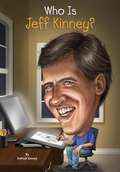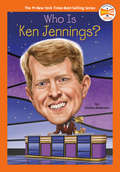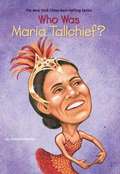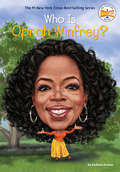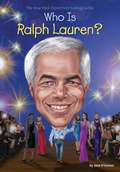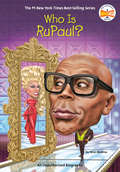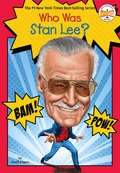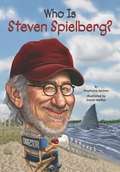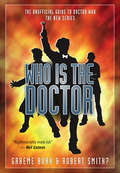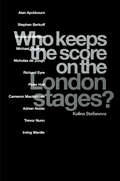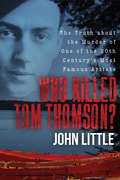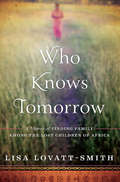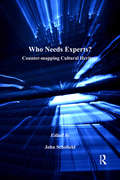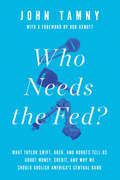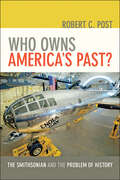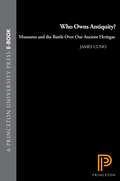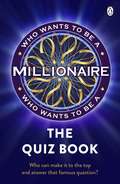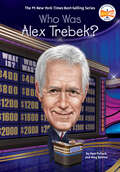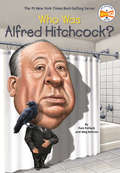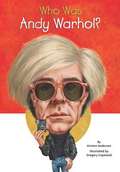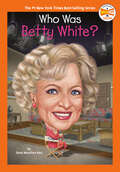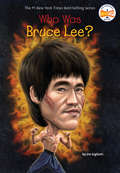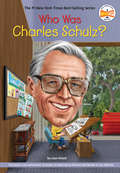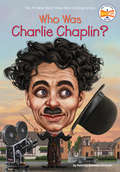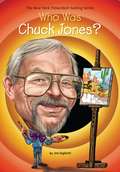- Table View
- List View
Who Is Jeff Kinney?
by Patrick Kinney John HinderliterEven as a kid, everyone thought Jeff Kinney was talented. People loved his drawings, and when he went to college, his comic strip Igdoof was so popular that it spread to other universities! Still, Jeff faced challenges. His cartoons were rejected by syndicates that claimed his art was unprofessional. Then, an idea struck: Jeff would write a journal from the perspective of a child, illustrated with doodles just like a kid might do. And so, the Diary of a Wimpy Kid series was born--and it was a hit! In this biography, Jeff's brother, Patrick Kinney, provides a knowledgeable look at the life of this best-selling author/illustrator. From Jeff's childhood pranks to his job developing online games, kids will love the chance to learn more about the creator of the popular Wimpy Kid books.
Who Is Ken Jennings? (Who HQ Now)
by Kirsten Anderson Who HQPart of the #1 New York Times bestselling series, this Who HQ Now book tells the amazing story of an unknown trivia buff who became the all-time greatest contestant on Jeopardy! Ken Jennings is considered the greatest of all-time contestants on Jeopardy! and became a household name after his impressive 74-game winning streak. After the passing of longtime host Alex Trebek, Jennings became the first guest to host Jeopardy! Read more about Ken Jennings and his curious life in this Who HQ Now biography.
Who Is Maria Tallchief?
by Catherine GourleyBorn in 1925, Maria Tallchief spent part of her childhood on an Osage reservation in Oklahoma. With the support of her family and world-renowned choreographer George Balanchine, she rose to the top of her art form to become America's first prima ballerina.
Who Is Oprah Winfrey? (Who Was?)
by Barbara Kramer Who HQThe story of how a young Southern girl who was raised on a pig farm became one of the most influential and inspiring people in the world.We all know Oprah Winfrey as a talk-show host, actress, producer, media mogul, and philanthropist, but the "Queen of Talk" wasn't always so fortunate. She suffered through a rough childhood and went on to use her personal struggles as motivation. Oprah's kindness, resilience, and determination are just some of the many reasons why her viewers--and people all around the world--love her. The richest African American person of the twentieth century, Oprah is often described as the most influential woman in the world.
Who Is Ralph Lauren? (Who was?)
by Jane O'Connor Stephen Marchesi Who HqThe polo player with the raised mallet—everyone knows the Ralph Lauren logo. Learn the amazing story of the man who is a true American fashion icon.Born in the Bronx, even as a teenager Ralph Lauren was known for his distinctive fashion sense, having a taste for both classic preppy clothes and vintage looks like beat-up leather jackets. He got his start in the fashion business by selling ties that he designed. From ties he went on to create a global fashion empire. In this easy-to-read biography, best-selling author and Who Was? creator Jane O'Connor explains exactly how a fashion line is created—from first drawings to models strutting on the runway.
Who Is RuPaul? (Who Was?)
by Nico Medina Who HQLearn how this Emmy-winning host, producer, and television personality became the world's most famous drag queen.RuPaul Andre Charles always knew he was meant to be a performer. Even as a young child, he loved to dress up and imitate the glamorous women he saw on television. When he turned fifteen, he began studying theater in a performing arts school in Atlanta and never looked back. Ru developed his drag-queen personality and launched his career in the 1980s. He now hosts and judges the widely popular and long-running show RuPaul's Drag Race, which has raised the profile of the art of drag, and drag queens around the world.
Who Is Stan Lee? (Who was?)
by Geoff Edgers Nancy Harrison John HinderliterStanley Lieber was just seventeen when he got his first job at Timely Comics in 1939. Since then, the man now known as Stan Lee has launched a comic book empire, made Marvel Comics a household name, and created iconic superheroes such as Iron Man, Spider-Man, and the Fantastic Four. Stan Lee is still dreaming up caped crusaders and masked vigilantes in his nineties. Who Is Stan Lee? tells the story of a New York City kid with a superhero-sized imagination.
Who Is Steven Spielberg?
by Stephanie Spinner Daniel MatherWhile other kids played sports, Steven Spielberg was writing scripts and figuring out camera angles. He went from entertaining his Boy Scout troop with home movies to amazing audiences around the world with epic blockbusters. He has directed four of the most successful films of all time and has won two Academy Awards for Best Director. From Jaws to Lincoln, young readers and aspiring filmmakers will be fascinated by the life of this famous director.
Who Is the Doctor: The Unofficial Guide to Doctor Who: The New Series (Who Is the Doctor #1)
by Robert Smith Graeme Burk&“A joyful celebration of fan love. Unofficial episode guides don&’t come much more engaging than this&” (Benjamin Cook, co-author of Doctor Who: The Writer&’s Tale). Doctor Who was already the world&’s longest-running science fiction series when it returned in 2005 to huge success. Enormously popular, the BBC show encompasses multiple other genres, from horror to comedy to action and historical adventure, and is loved for its uniquely British wit and clever scripting. Its hero, its monsters, and even its theme song have become pop culture icons. In this volume covering six seasons of the new series, two Doctor Who experts provide insights into everything from the history of the show, including Daleks, Cybermen, and the eight Classic Series Doctors, to a detailed episode guide. As Neil Gaiman complained to the authors, &“I have just lost four hours to your blasted book. And I only meant to glance at it.&” Allons-y!
Who Keeps the Score on the London Stages?
by Kalina StefanovaHow does one become a theater critic in London? What do the theater critics think of their profession? How are they judged by those they critique? What do both critics and theatre-makers think of their mutual object of desire - the British Theatre?Who Keeps the Score on the London Stages? sets out to find the answers to these questions and many more in this long overdue publication on Britain's current theatre scene. Included are comprehensive interviews with more than fifty major London theatre critics and theater-makers, including Sir Alan Ayckbourn, Stephen Berkoff, Michael Billington, Martin Coveney, Nicholas de Jongh, Sir Richard Eyre, Sir Peter Hall, Sir Cameron Mackintosh, Adrian Noble, Sir Trevor Nunn and Irving Wardle. The author has gathered together a lively discussion about the contrmporary state of the British theatre, drawing a picture of its strengths, weaknesses and the problems it faces today. This volume serves as a long overdue guide to the Theatre critics' profession in Britain.
Who Killed Tom Thomson?: The Truth about the Murder of One of the 20th Century's Most Famous Artists
by John LittleTom Thomson was Canada's Vincent van Gogh. He painted for a period of five years before meeting his untimely death in a remote wilderness lake in July 1917. He was buried in an unofficial grave close to the lake where his body was found. About eight hours after he was buried, the coroner arrived but never examined the body and ruled his death accidental due to drowning. A day and a half later, Thomson's family hired an undertaker to exhume the body and move it to the family plot about 100 miles away. This undertaker refused all help, and only worked at night. In 1956, John Little's father and three other men, influenced by the story of an old park ranger who never believed Thomson's body was moved by the undertaker, dug up what was supposed to be the original, empty grave. To their surprise, the grave still contained a body, and the skull revealed a head wound that matched the same location noted by the men who pulled his corpse from the water in 1917. The finding sent shockwaves across the nation and began a mystery that continues to this day. In Who Killed Tom Thomson? John Little continues the sixty-year relationship his family has had with Tom Thomson and his fate by teaming up with two high-ranking Ontario provincial police homicide detectives. For the first time, they provide a forensic scientific opinion as to how Thomson met his death, and where his body is buried. Little draws upon his father's research, plus recently released archival material, as well as his own thirty-year investigation. He and his colleagues prove that Thomson was murdered, and set forth two persons of interest who may have killed Tom Thomson.
Who Knows Tomorrow: A Memoir of Finding Family among the Lost Children of Africa
by Lisa Lovatt-SmithBorn in Spain and raised by a struggling single mother, Lisa Lovatt-Smith became an editor at British Vogue at nineteen, the youngest in Condé Nast history. She helped launch Spanish Vogue and partied across Europe with celebrities, fashion designers, photographers, and supermodels. By her thirties, Lisa has her dream career and a glamorous life in Paris, but when her adopted daughter Sabrina is expelled from school, Lisa takes her to volunteer in a Ghanaian orphanage in the hopes of getting her back on track. What she discovers there changes both their lives for good. Appalled by the deplorable conditions she finds, Lisa moves to Ghana permanently and founds OAfrica, dedicating her personal resources to reuniting hundreds of Ghanaian children with their families and spearheading a drive to shut down corrupt orphanages. On this unforgettable journey, Lisa confronts death threats, malaria, arson, and heartbreaking poverty; she also discovers truly inspiring children trapped in limbo by a moneymaking scheme bigger than she ever imagined. Who Knows Tomorrow is the engaging, frank, and often surprisingly funny story of one amazing woman who has traveled the globe in search of meaningful connection. Although to Lisa her story will always be about the children, it’s also a touching celebration of a woman who is talented, generous, and unfailingly courageous.
Who Needs Experts?: Counter-mapping Cultural Heritage (Heritage, Culture and Identity)
by John SchofieldTaking the significant Faro Convention on the Value of Cultural Heritage for Society (Council of Europe 2005) as its starting point, this book presents pragmatic views on the rise of the local and the everyday within cultural heritage discourse. Bringing together a range of case studies within a broad geographic context, it examines ways in which authorised or 'expert' views of heritage can be challenged, and recognises how everyone has expertise in familiarity with their local environment. The book concludes that local agenda and everyday places matter, and examines how a realignment of heritage practice to accommodate such things could usefully contribute to more inclusive and socially relevant cultural agenda.
Who Needs the Fed?: What Taylor Swift, Uber, and Robots Tell Us About Money, Credit, and Why We Should Abolish America's Central Bank
by John TamnyThe Federal Reserve is one of the most disliked entities in the United States at present, right alongside the IRS. Americans despise the Fed, but they're also generally a bit confused as to why they distrust our central bank.Their animus is reasonable, though, because the Fed's most famous function-targeting the Fed funds rate-is totally backwards. John Tamny explains this backwardness in terms of a Taylor Swift concert followed by a ride home with Uber.In modern times, he points out, the notion of credit has been perverted, so that most people believe it's money and that the supply of it can therefore be increased. This false notion has aggrandized the Fed with power that it can't possibly use wisely. The contrast between the grinding poverty of Baltimore and the abundance of Silicon Valley helps illustrate the problem, along with stories about Donald Trump, Robert Downey Jr., Jim Harbaugh (the Michigan football coach), and robots.Who Needs the Fed? makes a sober case against the Federal Reserve by explaining what credit really is, and why the Fed's existence is inimical to its creation. Readers will come away entertained, much more knowledgeable, and prepared to argue that the Fed is merely superfluous on its best days but perilous on its worst.
Who Owns America's Past?: The Smithsonian and the Problem of History
by Robert C. PostWhen preserving our history, what do we choose to value, why, and who decides?Honorable Mention for the National Council on Public History Book Award of the National Council on Public HistoryIn 1994, when the National Air and Space Museum announced plans to display the Enola Gay, the B-29 sent to destroy Hiroshima with an atomic bomb, the ensuing political uproar caught the museum's parent Smithsonian Institution entirely unprepared. As the largest such complex in the world, the Smithsonian cares for millions of objects and has displayed everything from George Washington's sword to moon rocks to Dorothy’s ruby slippers from The Wizard of Oz. Why did this particular object arouse such controversy? From an insider’s perspective, Robert C. Post’s Who Owns America’s Past? offers insight into the politics of display and the interpretation of history.Never before has a book about the Smithsonian detailed the recent and dramatic shift from collection-driven shows, with artifacts meant to speak for themselves, to concept-driven exhibitions, in which objects aim to tell a story, displayed like illustrations in a book. Even more recently, the trend is to show artifacts along with props, sound effects, and interactive elements in order to create an immersive environment. Rather than looking at history, visitors are invited to experience it.Who Owns America’s Past? examines the different ways that the Smithsonian’s exhibitions have been conceived and designed—whether to educate visitors, celebrate an important historical moment, or satisfy donor demands or partisan agendas. Combining information from hitherto-untapped archival sources, extensive interviews, a thorough review of the secondary literature, and considerable personal experience, Post gives the reader a behind-the-scenes view of disputes among curators, academics, and stakeholders that were sometimes private and at other times burst into headline news.
Who Owns Antiquity? Museums and the Battle Over Our Ancient Heritage
by James CunoWhether antiquities should be returned to the countries where they were found is one of the most urgent and controversial issues in the art world today, and it has pitted museums, private collectors, and dealers against source countries, archaeologists, and academics. Maintaining that the acquisition of undocumented antiquities by museums encourages the looting of archaeological sites, countries such as Italy, Greece, Egypt, Turkey, and China have claimed ancient artifacts as state property, called for their return from museums around the world, and passed laws against their future export. But in Who Owns Antiquity?, one of the world's leading museum directors vigorously challenges this nationalistic position, arguing that it is damaging and often disingenuous. "Antiquities," James Cuno argues, "are the cultural property of all humankind," "evidence of the world's ancient past and not that of a particular modern nation. They comprise antiquity, and antiquity knows no borders." Cuno argues that nationalistic retention and reclamation policies impede common access to this common heritage and encourage a dubious and dangerous politicization of antiquities--and of culture itself. Antiquities need to be protected from looting but also from nationalistic identity politics. To do this, Cuno calls for measures to broaden rather than restrict international access to antiquities. He advocates restoration of the system under which source countries would share newly discovered artifacts in exchange for archaeological help, and he argues that museums should again be allowed reasonable ways to acquire undocumented antiquities. Cuno explains how partage broadened access to our ancient heritage and helped create national museums in Cairo, Baghdad, and Kabul. The first extended defense of the side of museums in the struggle over antiquities, Who Owns Antiquity? is sure to be as important as it is controversial.
Who Wants to be a Millionaire - The Quiz Book
by Sony Pictures Television UK Rights LtdHave you got what it takes? Sharpen your mind with Who Wants to be a Millionaire - The Quiz Book and see if you would win the £1,000,000 jackpotAnd remember, no cheating . . .__________Sir Seretse Khama was the first president of which country?A: BotswanaB: TanzaniaC: GhanaD: Zambia...For £1,000,000, what is your final answer?__________Only five people on UK screens have ever answered their way to the top and taken home the full cash prize.The question is, could you become a winner?Whether you're confident quizzer or trivial about trivia, Who Wants to Be a Millionaire - The Quiz Book is perfect for a solo test of knowledge or the ultimate at-home quiz with family and friends.Complete with all four life-lines and over 1,000 brand new questions, and written by brains behind the classic show, you can recreate Who Wants to Be a Millionaire from your home. Now there's only one question that really matters . . .Do you have what it takes?
Who Was Alex Trebek? (Who Was?)
by Pam Pollack Meg Belviso Who HQClue: A former journalist who became the beloved host of America's favorite game show and quiz competition. Answer: Who Was Alex Trebek?, the latest title in the #1 New York Times Best-Selling series.Born in Ontario, Canada, in 1940, Alex Trebek grew up listening to the radio and hoping to one day become a broadcaster. His dream became a reality when he was hired as a reporter for the Canadian Broadcasting Corporation in 1961. Alex's composed nature and ability to skillfully improvise while on television eventually led to his role as the host of Jeopardy!, the biggest quiz game show in the United States. Alex not only earned numerous awards over the course of his thirty-six-year-long hosting career, but he also earned the admiration of the contestants on the show and dedicated viewers watching at home.
Who Was Alfred Hitchcock? (Who was?)
by Meg Belviso Nancy Harrison Pamela D. Pollack Jonathan MooreKnown as one of the most influential filmmakers of all time, Alfred Hitchcock's unique vision in movies like Psycho and The Birds sent shivers down our spines and shockwaves through the film industry. His innovative camera techniques have been studied for decades and his gift for storytelling cemented his place in history. Many directors make great movies, but the genius of Hitchcock helped make movies great. Learn how a chubby boy from London became the "Master of Suspense."
Who Was Andy Warhol? (Who was?)
by Nancy Harrison Kirsten Anderson Gregory CopelandBest known for his screen prints of soup cans and movie stars, this shy young boy from Pittsburgh shot to fame with his radical ideas of what "art" could be. Working in the aptly named "Factory," Warhol's paintings, movies, and eccentric lifestyle blurred the lines between pop culture and art, ushering in the Pop Art movement and, with it, a national obsession. Who Was Andy Warhol? tells the story of an enigmatic man who grew into a cultural icon.
Who Was Betty White? (Who HQ Now)
by Dana Meachen Rau Who HQLearn about the remarkable life of actress and comedian Betty White, a pioneer of early television with a seven-decade career, in this title in the Who HQ Now series featuring newsmakers and trending topics.From 1939 to 2021, actress Betty White was one of the most beloved performers in the entertainment industry. She starred in fan-favorite television shows like The Golden Girls and The Mary Tyler Moore Show, and also blockbuster movies like Toy Story 4 and The Proposal. Over her decades-long career, Betty White won Emmy awards, was named an honorary mayor of Hollywood, earned a star on the Walk of Fame, and set the Guinness World Record for woman with the longest TV career ever. Off-screen, Betty advocated for animal rights, racial justice, and LGBTQIA+ rights. Learn about her legendary life in this book for young readers.
Who Was Bruce Lee? (Who was?)
by Nancy Harrison John Hinderliter Jim GigliottiBruce Lee was a Chinese American action film star, martial arts instructor, filmmaker, and philosopher. His Hong Kong and Hollywood-produced films elevated the traditional martial arts film to a new level of popularity and acclaim. Through such films as Way of the Dragon and Enter the Dragon, Lee helped to change the way Asians were presented in American films and, in the process, he became an iconic figure known throughout the world. Although he died at the young age of 32, Bruce Lee is widely considered to be the one of the most influential martial artists of all time.
Who Was Charles Schulz? (Who Was?)
by Joan Holub Who HQLearn more about the cartoonist who created Charlie Brown, Snoopy, and the rest of the lovable Peanuts gang in this new addition to the #1 New York Times bestselling series!Charles (otherwise known as Sparky) Schulz always loved drawing from the time he was a young child, and as he grew older, he turned this passion into a phenomenally successful career. His early doodles of his mischievous dog and of a shy boy inspired two of his most familiar and beloved characters, Charlie Brown and Snoopy. Here's the story about Peanuts gang and Charles's life that's sure to excite all readers but especially those who love the classic cartoon series.
Who Was Charlie Chaplin? (Who was?)
by Patricia Brennan DemuthWho was the real Charlie Chaplin? Kids will learn all about the comic genius who created "The Little Tramp"!Charlie Chaplin sang on a London stage for the first time at the age of five. Performing proved to be his salvation, providing a way out of a life of hardship and poverty. Success came early and made Chaplin one of the best loved people in the United States until the McCarthy witch hunts drove Chaplin from his adopted country. This is a moving portrait of a multi-talented man--actor, director, writer, even music composer--and the complicated times he lived in.
Who Was Chuck Jones? (Who was?)
by John Hinderliter Jim Gigliotti Who Hq"What's Up, Doc?" Find out in this lively biography of the most celebrated director in animation history!Charles Martin "Chuck" Jones was an American animator, cartoon artist, screenwriter, producer, and director of many classic animated cartoon shorts. They starred Bugs Bunny, Daffy Duck, the Road Runner and Wile E. Coyote, Pepé Le Pew, Porky Pig and a slew of other Warner Brothers characters. When he moved on to Metro-Goldwyn-Mayer, his work includes a series of Tom and Jerry shorts as well as the television adaptation of Dr. Seuss's How the Grinch Stole Christmas. Jones was nominated for eight Academy Awards, won three, and received an honorary Oscar for his work in the animation industry. His career spanned almost seventy years, during which he made over 250 animated films, including What's Opera, Doc?, a classic Bugs Bunny/Elmer Fudd short that is considered to be one of the greatest cartoons of all time.
